1. Do Not Mess with the Tobacco Industry
Going way back to about 1978, our MIT lab spent much time on biomagnetic research of the lung. One quantity we measured was called the “clearance curve”. The idea was this: if the subject inhaled some harmless ferromagnetic dust, such as iron oxide, then we could sequentially track the amount of remaining dust, as the lung cleared out its dust. We magnetized the chest with a large magnet, then made a measurement of the magnetic field over the chest, which was proportional to th e amount of dust remaining in the lung (see my Science paper of 1972). Our physiology collaborator was Prof. Joe Brain of the Harvard School of Public Health, an expert on dust in the lung, including its clearance out of the lung.
In our particular project, we measured the dust clearance rate of normal subjects versus a small group of smokers. Not surprisingly, smokers' lungs cleared the magnetic dust much slower than normal lungs. This was a definite and important proof, showing one reason why smokers developed lung cancer: this was from retained dust. We published the results in Science, and received good press notice.
But the tobacco people didn’t like those press notices, and they quietly declared war on our little, unsuspecting group. I suppose this was supposed to be a lesson to other scientists. In their attack, they used an organization they funded, called “The Council for Tobacco Research” or some such name. This organization in turn funded various pro-tobacco projects, including the activities of a statistician by the name of Ted Sterling, of Simon Fraser University, now deceased. He wrote to MIT officials and told them that we were poisoning our student subjects by having them inhale the iron oxide, which he claimed was a carcinogen. He also lured several biomagnetic lung researchers, in a sense our competitors, into backing him up (don’t even try to guess). I believe he quoted them. Well of course the MIT administrators responded, and ordered a hearing into the matter. This took place in the office of Ben Lax, director of the Magnet Lab. Joe Brain and I were the defense team. Joe, a noted expert, testified that iron oxide was not carcinogenic, but was indeed harmless. The administrators then ruled our experiments to be okay and we were allowed to continue our research, as we wished. Further, all future mailings from the relentless Ted Sterling were ignored by the administrators, or returned.
Now I have never seen this sort of war before, and I was intimidated. I decided “this sort of trouble I don’t need”. And I simply got out of the human lung business. I closed down that shop. Joe continued his own clearance project and expanded the work, but using his small lab animals, and went far in developing the field dealing with the magnetic activity of cells. But I backed away from that stuff.
Moral of this story: Do not mess with the tobacco industry.
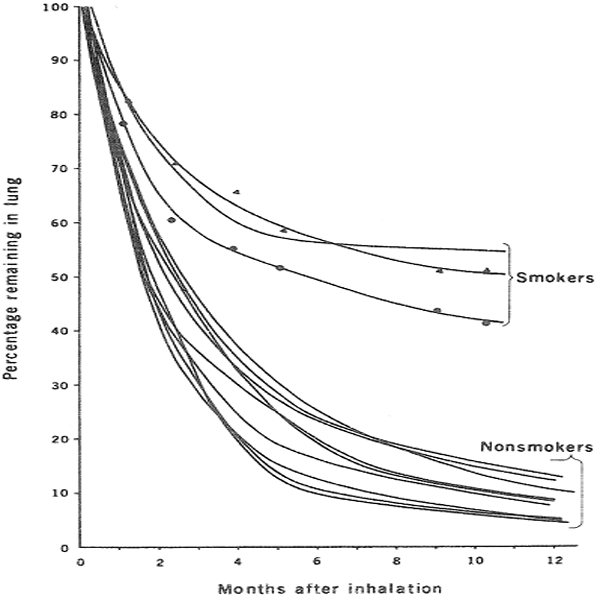
From Science paper. Dust clearance curves of 3 smokers vs 9 non-smokers. Smokers lungs were found to clear dust about five times slower than normal. Therefore, smokers are much more prone to cancer from carcinogenic dust.
2. An Unsung Hero of Biomagnetism
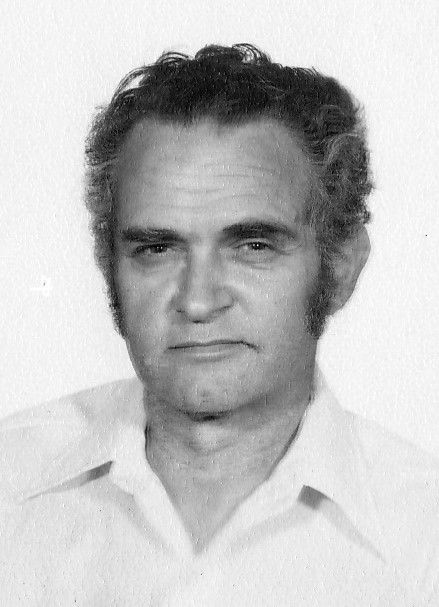 This is the story of a hero of biomagnetism who never got any credit. His name was Lester Winsberg. He passed away about 30 years ago, but I want to tell you what he did.
This is the story of a hero of biomagnetism who never got any credit. His name was Lester Winsberg. He passed away about 30 years ago, but I want to tell you what he did.
In the years 1957-1965, when I was an accelerator physicist, I carpooled every day, from the south side of Chicago to the Argonne National Laboratory, about 30 miles (one hour). For years it was a steady carpool, day-by-day. At first we told jokes, for one or two years. Then, after running out of jokes, we were quieter in the car. Except, every day after he passed over the last railway tracks, we always said the same thing: “clear sailing from here on”. You get the general picture of this carpool…
But something happened in that dull carpool, at least to me. Lester was in my carpool, and we got to know each other quite well. Well, somehow he got the idea that I was super brilliant; I assure you it was all a mistake. One night, for my particle physics job, I had been looking at some quantum mechanics puzzle, which was way beyond me, but I somehow remembered the answer they gave. Well, wouldn’t you know it, the next day Lester told me, in the carpool, how he was struggling to solve that same puzzle, so I tossed off the answer like it was nothing! He looked at me in a funny way, and I think he began to mistakenly believe that I was some kind of physics guru.
Not long afterward, in 1964, he was appointed head of a new physics department, at the new U. of Illinois campus in Chicago. So he had to rapidly hire an entire department. Well, thinking I was something special, he asked me to be an associate professor of physics (with tenure after one year). And the main thing: he would give me the money to build a shielded room. He knew I wanted to switch careers, to measure the magnetic field of the human body, and in a shielded room; and he knew my Argonne proposal had just been refused. So I needed a new home to do Biomagnetism, and he offered me this home; he believed this project would succeed.
Well, I took the job. I soon left Argonne, joined the new U. of Illinois, and indeed Lester gave me the money and support to build the first shielded room for biomagnetism. That is where I confirmed the magnetic field of the heart, measured the first MEG, and measured the first DC over the human body. Baule and McFee, earlier and unknown to me, had measured the first magnetic field of the heart, but they were phasing out of magnetic stuff. Winsberg’s job allowed me to alone steer the experimental aspect of biomagnetism in its early direction. Without him, biomagnetism would have developed later and differently.
Epilogue: His promise of tenure did not hold up. He was soon voted out of office, sadly, and his replacement wanted no biomagnetism. The earlier promise of tenure meant nothing, and (luckily) I soon moved to MIT. But Lester Winsberg’s legacy lives on. He believed biomagnetism would succeed…
3. Is there New Info in the Magnetic Field ?
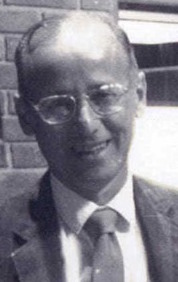 In the years 1963 to 1975, many of the electric and magnetic measurements of the body were those of the human heart. There was a thriving community studying the hearts' electric field (ECG), so that the first magnetic measurements (MCG) by Baule and McFee, then by me, were considered a curious sideline to the thriving ECG. But it was the ECG community that hospitably opened its doors to the MCG people. The prominent ECG theory people were Plonsey, Geselowitz, and others; and the prominent ECG experimental people we’re Dick McFee, Otto Schmitt, Eugene Lepeschkin, Stan Rush and others.They were really good, and their studies were described by these words: vector-cardiography, precordial mapping, lead field studies. But once the MCG was possible, they all took an interest and began to think about its’ possible uses.
In the years 1963 to 1975, many of the electric and magnetic measurements of the body were those of the human heart. There was a thriving community studying the hearts' electric field (ECG), so that the first magnetic measurements (MCG) by Baule and McFee, then by me, were considered a curious sideline to the thriving ECG. But it was the ECG community that hospitably opened its doors to the MCG people. The prominent ECG theory people were Plonsey, Geselowitz, and others; and the prominent ECG experimental people we’re Dick McFee, Otto Schmitt, Eugene Lepeschkin, Stan Rush and others.They were really good, and their studies were described by these words: vector-cardiography, precordial mapping, lead field studies. But once the MCG was possible, they all took an interest and began to think about its’ possible uses.
It is Stan Rush I want to talk about. He was an ECG mapper, who did torso studies as an engineering professor at the University of Vermont. He was an admirable and active guy, with many friends. He was a good researcher. I liked him a lot, and he looked over my shoulder at my MCG measurements.
He began to think about the MCG in a particular way: could it really contain new information, not available in the ECG? He attacked the problem using basic, tough physics: the divergence and curl of the ECG vector sources (or flow and vortex sources). Using the information that the heart sources are only dipole layers, he concluded that there can be no new information in the hearts magnetic field. Another physics statement would be that, because of dipole layers, there are no magnetic dipoles in the heart. He wrote up his result for publication in IEEE Trans. on Biomed. Eng., and he sent me a preprint. Well, I reacted strongly. With my active imagination, I worried that word would spread, that magnetic measurements were generally useless, not only for the heart, but for any organs. There would be a chance that biomagnetism would be finished before it really started! At least that was my fear.
As a result, I thought of delaying the publication of this paper, because he might somehow be wrong. So I asked Stanley to hold off, but he said no, he was sure of his results. Then I found out that the editor of that IEEE Trans. was Prof. Bill Siebert, who was actually at MIT. So, in my frustration I went to see him, and argued that Stanley’s paper could kill a new field of science. I asked him to get further reviews of that paper, because it was complicated enough to be really wrong. Seibert said he would think about it. Then he later phoned me and said he must go by the editor’s rules, and not put up roadblocks for any paper. Now I was really worried. Further, Stan wrote me an angry personal letter, in longhand, threatening to sue me personally for trying to stop his work. I was surprised at how angry he was. What a messy scenario…
Well, dear reader, what do you suppose happened when this paper was printed? Absolutely nothing! No news articles, no nothing. Essentially zero reaction. None talked about it, and my phone did not ring. My fears have been exaggerated. Perhaps the paper was too complex, and noone could understand it. We now see that the number of citations for that paper is only 41, in 40 years. A small amount. Not what Stanley had hoped for. My big fuss was for nothing!
Moral of the story: When guns are firing, keep cool. Don’t lose your head…
Epilogue: Don’t worry, dear reader, this has little to do with the MEG. Rush’s work only concerns continuous dipole layers, which do not exist with pyramidal cells in the brain…. The idea of new info in the MEG as compared with the EEG, is a different matter entirely, and there might indeed be vortex sources (magnetic dipoles) in the brain, perhaps involving weird cortical folds. The question of the type of independent information in the MEG is still being actively explored.
Here is a peek at the Rush paper:
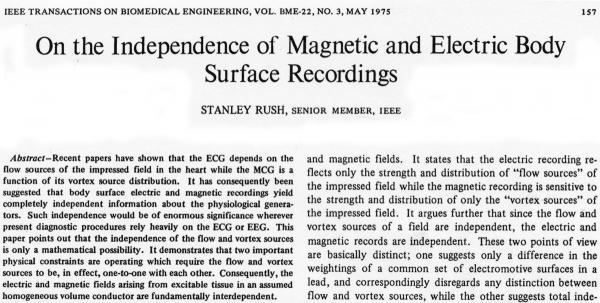
4. Great Moments: “Shaking” a Magnetic Shield
I want to talk about some great moments I’ve had in research, where I saw new phenomenon, usually for the first time. Some special phenomena in particular held my fascination, while other new phenomena did not seem to interest me. One of these special phenomenon was ”shaking”. I was intrigued by this thing; don’t ask me why.
Let me explain shaking, as used in my work. Shaking has something to do with high-mu ferromagnetic shielding material, like mu-metal or moly-permalloy. These are the materials of magnetic shields. Note that this phenomenon is only indirectly connected with biomagnetism, in that magnetic shielding is usually necessary for biomag measurements.
Shaking is this: when you pass a continuous alternating sine-wave magnetic field through the ferromagnetic walls of the shield, the field swings the magnetic domains back-and-forth, thereby shaking them up. When you degauss something, you do that sort of thing, except its not really shaking, because you swing the domains hard, then weaker and weaker, till zero, and the domains forget that they were once aligned together (magnetized). In what I call shaking, you don’t decrease to zero—you let the shaking continue, and not hard.
It turns out, when you shake, that the permeability mu increases. That is, the domains are more easily manipulated by a new slow outside magnetic field. Shake fast, to make slow things happen better.
I cannot recall everything in great detail (almost 50 years ago). I was designing my first shielded room, Illinois, and I was looking for ways to maximize the shielding. My logic was: maximize the shielding means maximizing the permeability. But how to do it? Then it dawned on me, my eureka moment. Always keep shaking the metal continuously at 60 Hz, so the domains easily lineup against lower disturbances we are shielding against, say 1 or 2 Hz. That is, artificially raise the permeability. Use shaking to improve shielding!
So I tested this idea with a simple cylindrical shield. See figure below, from pub. The shield became a factor of 2 or 3 better. In a sense, I could now switch the shielding between high and low! This really tickled my fancy, and I incorporated this shaking into my Illinois room, then later into my MIT room, which gave me much pleasure. But there is a price to pay --- a new big 60-Hz field inside the room, to cope with. I found fancy ways to deal with this, but this 60-Hz problem seemed to prevent others from using it in their shielded rooms. Therefore it is not yet accepted.
But, I have had a great moment with shaking…
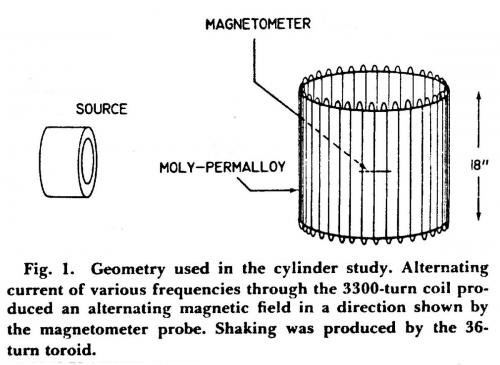
5. Jim Zimmerman, main inventor of our magnetic detector, the SQUID
Jim is the main inventor of the SQUID, and I believe all his technical achievements are well-documented. so I won’t go near the technical aspects of what he did; but instead I will 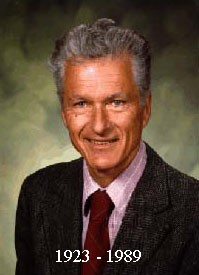 make some comments about Jim the person, as seen through my eyes. I vividly remember many things about him, even though I mostly dealt with him about 45 years ago.
make some comments about Jim the person, as seen through my eyes. I vividly remember many things about him, even though I mostly dealt with him about 45 years ago.
I first met him when he brought his SQUID to my shielded room at MIT, in late December 1969; that was when we made our well-known first Biomag SQUID measurement. I knew him progressively better during 8 or 10 subsequent visits to MIT, to fix and adjust the SQUID, and one or more visits I made to him in Boulder, CO. And of course we spent time together at various scientific meetings. We did not become close friends, but I would say we were respectful colleagues.
My main feeling when I think of Jim, is that of quiet pleasure --- it was easy to be around him. He was somewhat aloof, but pleasantly so. He was certainly non-threatening. He was simple, straightforward, and honest, and he scoffed at ambitious or pushy types. He had no use for pomp and show. There were one or two physicists in the field of Josephson Junctions who were a bit pompous and glory seeking, and he held them in low regard. Their names are now mostly forgotten, But of course his name will go on forever.
Some of his main pleasure were skiing and gardening; I believe he shared both with his wife Ida. Here is one example of his basic simplicity: given the choice, when he flew to another lab for a few days, he would not stay in a hotel, but he elected to simply sleep on a cot or sofa, in the lab. At our MIT magnet Lab, he found a shower somewhere, and he was all set. He got no kick out of fancy rooms and big hotels, and laughed those who do. Although he was a handsome man, of striking appearance, he took no advantage of this. When I took him to a big party in Cambridge, he did not flirt at all; in fact, he sat quietly in a corner and mostly was calculating “back of envelope”. In that regard, he was most content in this marriage to Ida.
When he passed away in 1989, the world lost a true scientist.